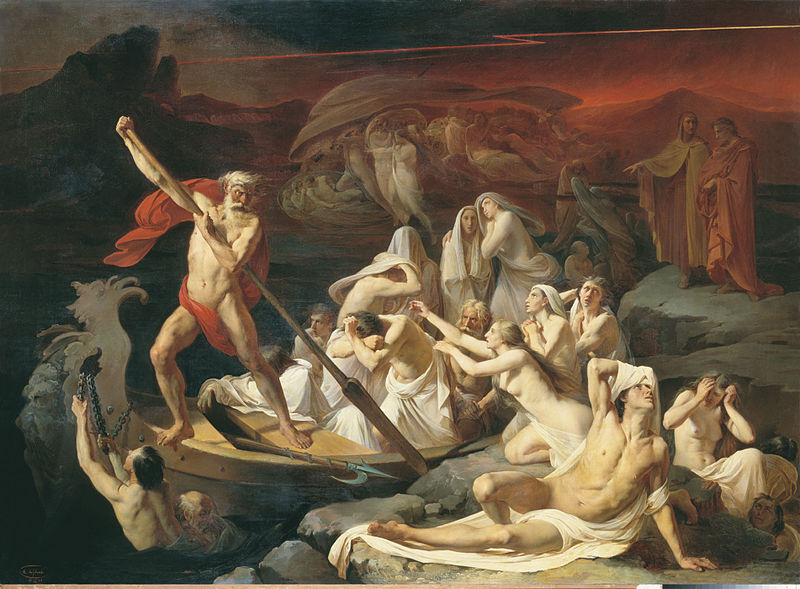Charon, the ferryman of Greek mythology, carrying souls across the river Styx to the underworld.
Discovery of Charon – 22nd June 1978.
Charon, the largest moon of the (minor) planet Pluto was discovered 42 years ago today. Working at the US Naval Observatory the astronomer James Christy (15/09/1938 – ) under supervisor Bob Harrington (21/10/1942 – 23/01/1993) was examining photographs of Pluto. He noticed a blob apparently attached to the (overexposed) image (resolution of images of Pluto from terrestrial-based telescopes are still rather coarse) which appeared to co-rotate around the planet. After 10 days of subsequent observations Christy and Harrington concluded that the blob was a satellite of the planet and they announced the discovery on the 7th July, 1978.
Charon, the largest moon of the (minor) planet Pluto was discovered 42 years ago today. Working at the US Naval Observatory the astronomer James Christy (15/09/1938 – ) under supervisor Bob Harrington (21/10/1942 – 23/01/1993) was examining photographs of Pluto. He noticed a blob apparently attached to the (overexposed) image (resolution of images of Pluto from terrestrial-based telescopes are still rather coarse) which appeared to co-rotate around the planet. After 10 days of subsequent observations Christy and Harrington concluded that the blob was a satellite of the planet and they announced the discovery on the 7th July, 1978.
Charon, la plus grande lune de la planète naine Pluton a été découverte il y a 42 ans, le 22 juin 1978. L’astronome James Christy (15/09/1938-) de l’Observatoire naval des Etats-Unis, sous la supervision de Bob Harrington, (21/10/1942-23/01/1993) était en train d’ètudier des photos de Pluton, quand il a remarqué une forme floue sur l’image de cette planète. Cette forme semblait tourner autour de la planète. Après 10 jours d’observations Christy et Harrington ont conclu que la forme indistincte était un satellite de Pluton, et ils ont annoncé la découverte le 7 juillet 1978.
The mass calculations then made possible by the discovery were undertaken by Harrington which showed that the Pluto system had a lower mass than the previous lowest estimates, and therefore would have insufficient gravitational perturbation effects to account for the anomalies observed in the orbits of Uranus and Neptune. This initiated the search for further trans-Neptunian objects (TNOs) culminating in the discovery in August 1992 of 15760 Albion, the first of many TNOs to now been known.
Charon has a captured orbital period and has the same orbital period as the rotation period of Pluto. It also has a captured rotation period (its rotation time is the same as its orbital period) and so it always faces the same hemisphere towards Pluto. (Our own Moon also has captured rotation).
At 606km in radius it is large enough to maintain a near-spherical shape. The Pluto / Charon system is a remarkable double-minor planet (Pluto has a radius of 1188 km) where the secondary (Charon) has a high ratio of radius (and mass) compared to the primary (Pluto). Regular readers of our blog will recall our article on binary asteroids.
The NASA New Horizons probe visited the Pluto system and had a close (29,000km) fly-past of Charon on the 14th July 2015. The images taken are truly spectacular and show many interesting features, including a 1600km length canyon, cliffs 6km high, and red colouration (due to methane) at its pole. NASA produced a short video of the discovery and nature of Charon in 2018 and this is very worthwhile viewing (see link here).
https://www.nasa.gov/feature/charon-at-40-four-decades-of-discovery-on-pluto-s-largest-moon
Whilst Charon is named after Christy’s wife (Charlene), its name was approved by the IAU because, coincidentally, Charon is also the name of the ferryman in Greek mythology who ferried the souls of the departed across the river Styx to the underworld. So, Charon is a fitting heavenly companion to Pluto, the Greek god of the underworld.
Charon is the largest of 5 moons of Pluto; the others being Styx, Nix, Kerberos and Hydra. It is a fascinating system.
Charon has a captured orbital period and has the same orbital period as the rotation period of Pluto. It also has a captured rotation period (its rotation time is the same as its orbital period) and so it always faces the same hemisphere towards Pluto. (Our own Moon also has captured rotation).
At 606km in radius it is large enough to maintain a near-spherical shape. The Pluto / Charon system is a remarkable double-minor planet (Pluto has a radius of 1188 km) where the secondary (Charon) has a high ratio of radius (and mass) compared to the primary (Pluto). Regular readers of our blog will recall our article on binary asteroids.
The NASA New Horizons probe visited the Pluto system and had a close (29,000km) fly-past of Charon on the 14th July 2015. The images taken are truly spectacular and show many interesting features, including a 1600km length canyon, cliffs 6km high, and red colouration (due to methane) at its pole. NASA produced a short video of the discovery and nature of Charon in 2018 and this is very worthwhile viewing (see link here).
https://www.nasa.gov/feature/charon-at-40-four-decades-of-discovery-on-pluto-s-largest-moon
Whilst Charon is named after Christy’s wife (Charlene), its name was approved by the IAU because, coincidentally, Charon is also the name of the ferryman in Greek mythology who ferried the souls of the departed across the river Styx to the underworld. So, Charon is a fitting heavenly companion to Pluto, the Greek god of the underworld.
Charon is the largest of 5 moons of Pluto; the others being Styx, Nix, Kerberos and Hydra. It is a fascinating system.
Two images of Charon; the insert is the ‘discovery’ image taken from Flagstaff in June 1978, the main picture was taken by the New Horizon probe on 14th July 2015 (courtesy NASA).



 RSS Feed
RSS Feed
